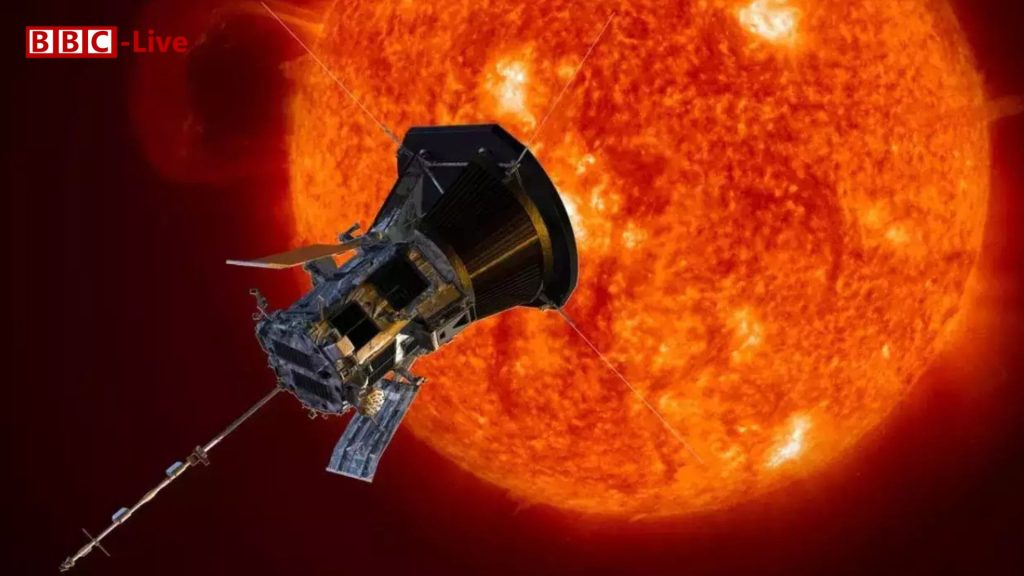
NASA’s Parker Solar Probe to Set New Record on Closest-Ever Pass of the Sun
NASA’s Parker Solar Probe is about to make history. On Christmas Eve, it will execute its closest approach to the Sun ever recorded. This event is scheduled for December 24 at 6:53 AM US Eastern Time (1153 GMT). The spacecraft will fly just 3.8 million miles (6.2 million kilometers) from the Sun’s surface. This milestone is a significant achievement for the probe’s mission.
A Groundbreaking Mission
The Parker Solar Probe was launched in August 2018. It is on a seven-year mission. The goal is to better understand the Sun. Scientists hope this knowledge will help improve our ability to predict space weather events. Such events can impact life on Earth.
A Unique Perspective on Distance
To illustrate the spacecraft’s closest pass, consider a football field. If the distance from Earth to the Sun were as long as that field, the Parker Solar Probe would be just four yards (3.65 meters) from the end zone. This comparison highlights the significance of this flyby. NASA scientists are excitedly looking forward to the initial data download from the spacecraft in the upcoming weeks.
What is Perihelion?
The close pass on Christmas Eve is called perihelion. During this event, the Parker Solar Probe will reach unprecedented extremes. While it is flying close to the Sun, the mission team will temporarily lose direct contact with the spacecraft. They will use a “beacon tone” to confirm its status during this time.
Braving Extreme Conditions
The spacecraft will endure extreme heat during its perihelion. Its heat shield will face temperatures ranging from 1,600 to 1,700°F (870 to 930°C). Despite these intense conditions, the probe’s internal instruments will remain safe and cool. They will be maintained at approximately 85°F (29°C).
During this flyby, the Parker Solar Probe will travel at an astonishing speed of around 430,000 mph (690,000 km/h). This speed is so incredible that it could allow the spacecraft to travel from Washington, DC, to Tokyo in under a minute.
Excitement from NASA Scientists
Nick Pinkine, the mission operations manager at the Johns Hopkins University Applied Physics Laboratory in Laurel, Maryland, expressed his excitement: “No human-made object has ever passed this close to a star. We’re excited to hear back from the spacecraft when it swings back around the Sun.”
Unprecedented Insights into the Sun
The Parker Solar Probe is providing scientists with extraordinary insights. It is helping researchers understand various aspects of the Sun’s behavior. This includes important questions about solar wind and why the Sun’s outer atmosphere, known as the corona, is hotter than its surface. The probe will also study the coronal mass ejections, which are large clouds of plasma that can significantly impact space weather.
Upcoming Flybys
The Christmas Eve flyby will not be the last close approach for the Parker Solar Probe. There are two more close passes planned. The next ones are scheduled for March 22, 2025, and June 19, 2025. Each of these flybys will help gather crucial data about the Sun. This knowledge will enhance our understanding of the Sun’s behavior and its effects on space weather.
Pushing the Limits of Space Exploration
As the Parker Solar Probe enters this uncharted territory, it pushes the boundaries of what we know about our solar system. This mission is solidifying its role as a vital tool in uncovering some of the greatest mysteries related to the Sun. The data gathered from these missions will lay the foundation for future research. It aims to benefit not just scientists but all of humanity.
Through this remarkable journey, the Parker Solar Probe continues to enhance our understanding of the threats posed by solar activity. By measuring and observing the Sun up close, it actively contributes to the study of space weather and its potential effects on Earth. Each new discovery from the probe is an exciting step toward grasping the complexities of our nearest star, and it is a testament to human ingenuity in space exploration.
The closest approach on Christmas Eve represents not only a scientific achievement but also a celebration of our quest for knowledge about the universe we inhabit. As we eagerly await the data from this landmark mission, we are reminded of how far we have come in our journey to understand the cosmos.




